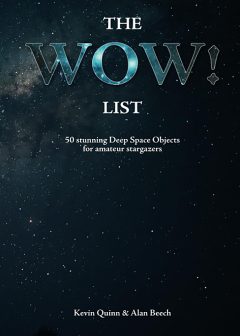The Wow! List
| By Kevin Quinn & Alan Beech | Reviewed by Callum Potter |
| Independently published 2023 | 124 pages |
| Price £16.50 | ISBN:979-8388644060 |

This thin volume of 124 pages is self-published by the authors and printed by Amazon. The aim of the book is to present a ‘definitive’ list of 50 deep-sky objects that will evoke a ‘wow!’ response from the viewer. Its intended audience is the beginner, as well as the more experienced observer. The text is written by Kevin Quinn, with Alan Beech providing images. The book is intended for visual observing, but it is noted that most of the objects will not appear to the eye in the same way as the accompanying photographs.
The Wow! List is divided into sections on stars, open clusters, globular clusters, nebulae, and galaxies, as well as a miscellany. That devoted to stars, which includes red and double stars, is particularly welcome as these are often overlooked in guidebooks to the night sky.
Each target is presented over two pages; one page has some basic details, discursive text, and an image, while the second has a star chart centred on the target. The text provides some good observational advice but is a bit brief. The images are rendered and printed well.
I found the star charts to be not very useful. They cover a large amount of sky (about 60×40 degrees), are very detailed, and even the largest text labels are difficult to read. I do not think a beginner would be able to make very much out of them, with many of the targets being lost in the morass. I would have suggested including a couple of charts, showing both the target location in the constellation and a close-up of the area, or to choose just one and to use some of the space for more textual discussion.
Each section ends with some general remarks about the set of targets.
I think all the information in the text is pretty accurate, though I would argue that while Messier 13 (the Great Globular Cluster, in Hercules) is ‘king’ from UK skies, it is not the best cluster visible in the northern hemisphere, as claimed; this crown should belong to Omega Centauri which can be viewed from southern Europe and the southern USA, which to my mind are both in the northern hemisphere. However, Omega Centauri and 47 Tucanae are noted in the general discussion about globulars.
There are a few typos, omissions, inconsistencies, grammar difficulties and a repeat of the way of working out the exit pupil of a telescope on the same page. I also found the author’s use of asides in parentheses rather distracting. I think the book would have benefited from copy-editing or proofreading by an experienced author or editor.
In any selection of objects for a ‘best of’ list, there will be debates about what is and what is not included – and this is part of the fun of such a book. I expect the authors long debated about what to put in and what not. I felt the North American Nebula was maybe a bit too difficult for the beginner, and M31 (the Andromeda Galaxy) usually evokes an ‘is that it?’ response rather than a ‘wow!’. And the author describes viewing many of the objects with his 20×80 binoculars, which cannot really be classified as a beginners’ instrument.
This book cannot be thought of as a one-stop. You would need a good star atlas, planetarium software or an app to find these targets, or to use a GoTo telescope.
In summary, this book is an interesting starting point with some good targets that might otherwise be overlooked. But I think there is not enough in the book itself to completely satisfy a beginner or more experienced observer.
Callum Potter is Director of the Deep Sky Section of the BAA
| The British Astronomical Association supports amateur astronomers around the UK and the rest of the world. Find out more about the BAA or join us. |
